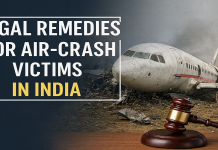This article has been written by S Chandrashekar, pursuing a Diploma in Advanced Contract Drafting, Negotiation, and Dispute Resolution from LawSikho.com.
Table of Contents
Introduction
Ever since Orville Wright and Wilbur Wright invented the flying machine, in 1903, aeroplanes have become an essential mode of domestic and international travel. Aeroplanes are used for carrying both passengers and cargo. In fact, during the recent ongoing COVID-19 pandemic India transported medicines like Remdesivir to the USA and other countries. Air travel is thus a lifesaver especially when time is of the essence.
Airplanes these days have huge sizes, high passenger capacity, high-powered engines, and innovative technological features. All these not only make the airline profitable by carrying passengers, reducing travel time but also ensure the safety of the aircraft.
The need for insurance in aviation
Air travel is fraught with many risks and dangers, some of which are very unique to the aviation industry like a technical failure, hijacking, bombing, and being shot down. Examples of such incidents include the hijacking of the Indian Airlines flight IC 814 from Kathmandu in Nepal to New Delhi, This flight was hijacked by Pakistani terrorists to Kandahar, in Afghanistan.
Malaysia Airlines Flight MH370 took off from Kuala Lumpur heading for the Chinese capital, Beijing suddenly disappeared from the Radar Screens some 39 minutes into the flight. Till today nothing is known about its disappearance, though various theories like hijacking, suicide by pilots, shooting down of the plane have been circulated till today nothing has been proved.
Another Flight MH 17 of the Malaysian Airlines was shot down on 17th July 2014 while on a routine flight from Amsterdam to Kuala Lumpur. The shoot-down occurred in the War in Donbass, during the Battle of Shakhtarsk Raion, in an area controlled by pro-Russian rebels. A Ukrainian airliner crashed outside Tehran in 2016 killing over 170 people. This was a Boeing 737 built-in 2016 and checked only two days before the accident. The Boeing 737 had departed Imam Khomeini International Airport before dawn and was bound for the Ukrainian capital Kiev, it crashed into farmland at Khalaj Abad, in Shahriar county, about 45 kilometers (30 miles) northwest of the airport, apparently due to a technical snag.
All the above incidents illustrate that the dangers of airline travel cannot be foreseen. Hence the need for airline insurance. Aviation insurance is unique insurance that has gained commercial acceptance and provides coverage to the specific operations of an aircraft and other possible risks in aviation. Aviation insurance is quite different from other types of transportation insurance. The clauses, terms, limits in aviation insurance are quite unique and are different from other types of insurance policies. Aviation insurance has gained momentum only recently, especially the attack on the Twin Towers on 11th September 2001. There are various forms of aviation policies as listed below:
In-flight coverage
This provides coverage against damages that can happen to the aircraft while it is in flight. Though this is costly, it is worth it as most accidents happen when a plane is in mid-air.
Hull all risk
There are many institutions/associations like flying clubs that operate small planes and medium-size planes, private jets belonging to celebrities/politicians/business tycoons, aircraft that are used for agricultural spraying pesticides, offering leisure rides, etc. Apart from providing insurance against any physical loss/damage to the insured plane, this policy also protects the plane against total loss and disappearance.
Loss of license
It is a statutory requirement for every aircraft crew member to have a valid license. There are times when such a license can be suspended on medical or disciplinary grounds. This leads to financial loss to the crew member. The crew member can get the coverage in case of permanent total disablement or temporary total disablement due to bodily injury or illness.
Spares all-risk insurance policy
If any loss/damage is incurred to the spares, tools, equipment, and supplies of the insured aircraft. This policy also covers any damages which are caused to a property by the aircraft.
Aviation personnel accident (crew member)
This is usually granted annually and protects the insured crew member against injury, disablement, or death as a result of an aircraft accident/mishap.
Exclusions : hull/spares war risk
War risk insurance
This is a type of insurance damage due to acts of war, including invasion, insurrection, rebellion, and hijacking are covered. Some policies also cover damage due to weapons of mass destruction. It is very frequently used in the shipping and aviation industries. This type of destruction insurance generally has two components: war risk liability, which covers people and items inside the aircraft and is computed based on the indemnity amount; and war risk hull, which covers the aircraft itself and is computed based on the value of the aircraft. The premium varies based on the expected stability of the countries to which the vessel will travel. An aircraft cannot operate without this clause since their loan and lease agreements clearly specify that this clause must be included in their insurance policy.
One of the reasons insurance companies were reluctant to include ‘WAR RISK’ in their insurance policies is because of the enormous amount of losses that would be caused to them. They would hardly be able to survive and would have to close down permanently.
War risk insurance policy is essential for airline companies that operate in war-struck zones and areas where there are terrorists. Some of these areas are Central, South America, West Asia, Nepal, Pakistan. During 1991, Gulf war airliners feared operating in the Gulf region due to the fear of being hit by the scud missiles which Iraq used to fire regularly. The airliners were also reluctant to get war insurance due to increased costs.
Sample war risk insurance clause
One of the most common provisions in commercial aviation hull and liability policies is known as Lloyd’s wording AVN 48B. This provision could appear in the basic policy form (i.e., the main text), or might appear by way of endorsement. It provides:
EXCLUSIONS APPLICABLE TO ALL COVERAGES:
WAR, HI-JACKING AND OTHER PERILS EXCLUSION CLAUSE (AVN 48B)
This policy does not cover claims caused by:
(a) War, invasion, acts of foreign enemies, hostilities (whether war be declared or not), civil war, rebellion, revolution, insurrection, martial law, military, or usurped power,
(b) Use of Nuclear Weapons or radiation.
Only the relevant portion relating to ‘WAR RISK’ has been reproduced above and other clauses not relevant have not been reproduced for the sake of brevity. Other forms of exclusion from AVN 48C and AVN 48D, which mention, for example, that loss caused by electromagnetic pulse and chemical and biologic pathogens also are excluded). From a reading of the above provision, it can be seen that the list of exclusion is pretty broad. Since many things that are listed are excluded, many terms have not been defined and are open to more than one interpretation. Terms such as “hostilities and “rebellion” are examples.
Features of AVN 48B
(i) It lists the dangers that are ordinarily excluded on the ground that they would result in huge losses which cannot be correlated. For example (e.g., nuclear war and declared war) with events (not really “perils”) that have a very remote possibility of happening maybe once in a lifetime and cannot be correlated (e.g., a “malicious act”).
(ii) It has a very broad scope. No matter how impossible the occurrence of a certain act may seem, if a policyholder wishes security under the circumstances encompassed by the exclusion, he ordinarily should seek a specific write-back of coverage.
This clause is an exclusion clause and not provided as a matter of routine in the aviation insurance policies.
Conclusion : benefits of war risk in the aviation insurance policy
War risk insurance though excluded under the aviation insurance policies can be availed of by a write back and need to be incorporated in the insurance policy.
Two major factors make a strong case for its inclusion
- Insurance companies cannot compute the premiums to be paid by the insured to cover the risk of war;
- The need for insurance companies to protect themselves against a financial disaster in the case of war.
All of our travel either for business or leisure. Thus air travel has become an inseparable part of our lives. However, air travel is fraught with many risks like turbulent weather, terrorist activities leading to hijacks, mysterious disappearance of flights, auto/technical failure, or a plane crash. Flying always encompasses life-threatening dangers.
Providing war risk insurance gives airline companies a competitive advantage. While having writebacks in the insurance policies, it is essential to scrutinize the wordings. Insurance companies will not write back all exclusions (such as hostile nuclear detonations). The same word may mean a difference in the basic policy and the write-back of the exclusion clause. One must have a proper understanding of the terms such as availability, cost, scope, and meaning of coverage for war, terror, and other such dangers. To have a proper write-back of the exclusion clause relating to war risk it is essential to have the involvement of the policyholder’s risk department, its aviation broker, and legal counsel.
Students of Lawsikho courses regularly produce writing assignments and work on practical exercises as a part of their coursework and develop themselves in real-life practical skills.
LawSikho has created a telegram group for exchanging legal knowledge, referrals, and various opportunities. You can click on this link and join:
 Serato DJ Crack 2025Serato DJ PRO Crack
Serato DJ Crack 2025Serato DJ PRO Crack










 Allow notifications
Allow notifications



